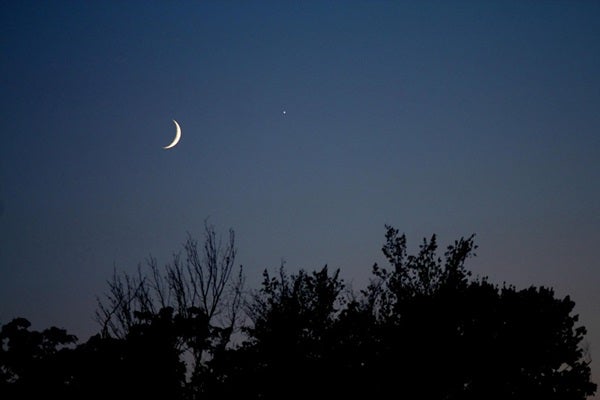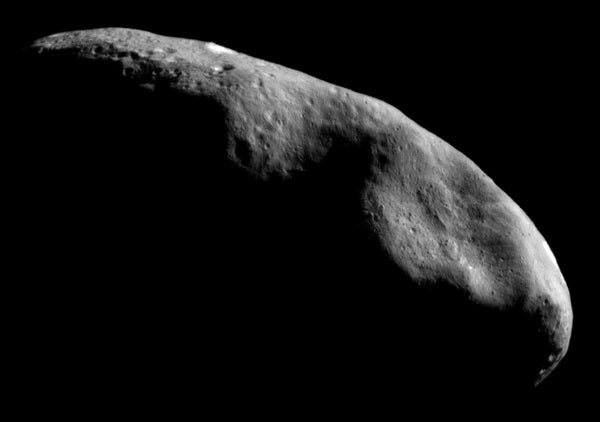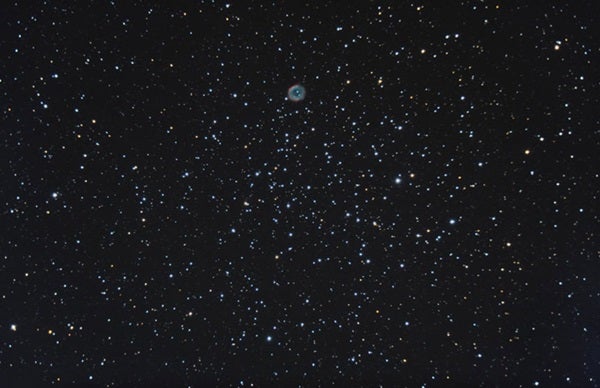One of the sky’s most familiar constellations rules January’s sky from dusk until around 2 a.m. local time. Orion the Hunter appears conspicuous in the southeast after darkness falls and climbs highest in the south around 9 p.m. It then stands halfway to the zenith from mid-northern latitudes. The night sky’s brightest star, Sirius, trails about an hour behind Orion.
Saturday, January 26
Mars continues to put on a nice show in January. Look for the Red Planet halfway to the zenith in the southwestern sky as darkness falls. The world shines at magnitude 0.8 against the much dimmer stars of southern Pisces. Tonight, Mars slides 0.9° south of the 4th-magnitude star Epsilon (ε) Piscium. A telescope reveals the planet’s 6″-diameter disk, but you likely won’t see any surface features unless you have exceptionally good seeing.
Sunday, January 27
Last Quarter Moon occurs at 4:10 p.m. EST. The Moon doesn’t rise until nearly 1 a.m. local time tomorrow morning, however, by which time it will appear slightly less than half-lit. The Moon spends the morning hours set against the background stars of northern Libra.
Monday, January 28
Although Uranus reached opposition and peak visibility more than three months ago, it remains a tempting target. The outer planet appears nearly 60° high in the southwest after darkness falls and doesn’t set until midnight local time. The magnitude 5.8 world lies in southeastern Pisces, some 1.4° north-northeast of the 4th-magnitude star Omicron (ο) Piscium. Although Uranus shines brightly enough to glimpse with the naked eye under a dark sky, use binoculars to locate it initially. A telescope reveals Uranus’ disk, which spans 3.5″ and shows a distinct blue-green hue.
Near-Earth asteroid 433 Eros continues its close encounter with Earth this week. It glows at 9th magnitude, bright enough to see through small telescopes. The asteroid resides in eastern Taurus, and tonight it passes 5° southwest of 2nd-magnitude Beta (β) Tauri. This region lies high in the east after darkness falls and passes nearly overhead around 9 p.m. local time. Be sure to catch Eros this month — it won’t be as close or as bright again until 2056.
Mercury reaches superior conjunction at 10 p.m. EST. This means the innermost planet lies on the opposite side of the Sun from Earth and remains hidden in our star’s glare. It will return to view in the evening sky in mid-February.
Wednesday, January 30
With each passing day, the waning crescent Moon rises about an hour later and appears lower in the southeastern sky before dawn. That’s a good thing for fans of conjunctions, because it sets up a string of pretty encounters with the bright morning planets. Today, the 24-percent-lit Moon hangs 6° to Jupiter’s upper right, and the two will barely squeeze into a single field of view through binoculars. Of course, magnitude –1.9 Jupiter is a treat all week. It currently rises shortly before 4 a.m. local time and climbs 20° high an hour before the Sun comes up. If you point a telescope at the giant world, you’ll see a 34″-diameter disk that features at least two conspicuous cloud belts.
Thursday, January 31
The waning crescent Moon stands 2° to the right of brilliant Venus this morning. The Sun now illuminates just 16 percent of our satellite’s disk, so it appears a bit dimmer than it did yesterday. And Venus shines at magnitude –4.3, some 10 times brighter than Jupiter. The Moon and Venus make a dazzling pair with the naked eye or through binoculars from the time they rise until twilight is well underway. If you aim a telescope at Venus this morning, you’ll see a 19″-diameter disk that appears 62 percent lit.
The constellation Puppis the Stern holds many wonderful open star clusters, but few equal the pair of M46 (seen here) and M47. Although both reward a look through binoculars, M46 has a bonus if you view it through a a 4-inch or larger telescope. The planetary nebula NGC 2438 sits just 7′ north of the cluster’s center. Most astronomers agree that NGC 2438 is a foreground object, somewhat fortunately superimposed upon M46.
A pair of fine binocular objects are on display during evenings this week. The open star clusters M46 and M47 reside about a degree apart in the northwestern corner of the constellation Puppis the Stern. The two lie about 12° east-northeast of the sky’s brightest star, Sirius. The western cluster, M47, glows at 4th magnitude and appears as a fuzzy patch sprinkled with several pinpoint stars. Sixth-magnitude M46 shows up as a hazy collection of faint stars that is hard to resolve under most conditions. Although it contains nearly twice as many stars as M47, M46 appears fainter and fuzzier because it lies some three times farther from Earth.
Saturday, February 2
Although Saturn passed on the opposite side of the Sun from Earth exactly one month ago, it already appears low in the southeast during morning twilight. From mid-northern latitudes, the ringed planet rises about 90 minutes before the Sun and climbs 10° above the horizon a half-hour before sunup. Saturn shines at magnitude 0.6 and should be fairly easy to pick out of the twilight. The waning crescent Moon makes the task even easier this morning. Its 5-percent-lit crescent appears 3° to the ringed planet’s lower left. Simply center the Moon through binoculars and look for the bright point of light near the field’s upper right edge.
For those who believe in folklore, the fate of winter rests on the shoulders of the groundhog. If the furry rodent sticks his head out of his burrow this morning and sees his shadow, we’ll have six more weeks of winter. But if the weather is cloudy, it means spring is right around the corner. What does this have to do with astronomy? Groundhog Day celebrates one of the four so-called cross-quarter days, which mark the midpoints between the solstices and equinoxes. February 2 falls approximately midway between the winter solstice and the vernal equinox.
Sunday, February 3
The variable star Algol in Perseus appears faintest at 11:55 p.m. EST, when it shines at magnitude 3.4. If you start watching it immediately after darkness falls, you can see it dim from its peak brightness (magnitude 2.1) to minimum and then start brightening again. This eclipsing binary star runs through a cycle from minimum to maximum and back every 2.87 days, but the drop from peak brightness and subsequent rise lasts only about 10 hours. Algol appears nearly overhead soon after darkness falls and descends toward the northwestern horizon well after midnight.












